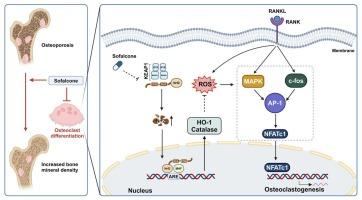Sofalcone inhibits osteoclastogenesis through Keap1/Nrf2 signaling activation and mitigates ovariectomy-induced bone loss
IF 4.7
2区 医学
Q2 IMMUNOLOGY
引用次数: 0
Abstract
Osteoporosis, a metabolic bone disorder, predominantly affects postmenopausal women and frequently results in pathological fractures. Current treatments for this condition often entail significant side effects, limiting their clinical utility. Sofalcone (SFC), a phenolic derivative isolated from the Chinese herb Sophora tonkinensis, has demonstrated antioxidative, anti-inflammatory, and anti-ulcer capabilities, has been less studied for its effects on osteoclasts and osteoporosis. Our in vitro studies reveal that SFC inhibits osteoclastogenesis and reduces osteoclastic bone resorption. It achieves this by enhancing the Kelch-like ECH-associated protein 1 (Keap1)/nuclear factor erythroid 2-related factor 2 (Nrf2) signaling pathway, which boosts the expression of antioxidant genes, decreases the production of reactive oxygen species (ROS), and suppresses activation of the mitogen-activated protein kinase (MAPK) signaling pathway. Further investigations using ovariectomized (OVX) mice have shown that SFC mitigates bone density loss and improves bone microarchitecture, suggesting its utility as both a preventive and therapeutic measure against osteoporosis.

软啡酮通过激活Keap1/Nrf2信号抑制破骨细胞生成,减轻卵巢切除术引起的骨质流失
骨质疏松症是一种代谢性骨骼疾病,主要影响绝经后妇女,经常导致病理性骨折。目前对这种疾病的治疗往往有明显的副作用,限制了它们的临床应用。Sofalcone (SFC)是一种从中草药苦参中分离出来的酚类衍生物,具有抗氧化、抗炎和抗溃疡的能力,但其对破骨细胞和骨质疏松症的影响研究较少。我们的体外研究表明,SFC抑制破骨细胞生成,减少破骨细胞骨吸收。它通过增强Kelch-like ECH-associated protein 1 (Keap1)/nuclear factor erythroid 2-related factor 2 (Nrf2)信号通路,促进抗氧化基因的表达,减少活性氧(ROS)的产生,抑制丝裂原活化蛋白激酶(MAPK)信号通路的激活来实现这一目标。对去卵巢小鼠的进一步研究表明,SFC可以减轻骨密度损失,改善骨微结构,这表明它可以预防和治疗骨质疏松症。
本文章由计算机程序翻译,如有差异,请以英文原文为准。
求助全文
约1分钟内获得全文
求助全文
来源期刊
CiteScore
8.40
自引率
3.60%
发文量
935
审稿时长
53 days
期刊介绍:
International Immunopharmacology is the primary vehicle for the publication of original research papers pertinent to the overlapping areas of immunology, pharmacology, cytokine biology, immunotherapy, immunopathology and immunotoxicology. Review articles that encompass these subjects are also welcome.
The subject material appropriate for submission includes:
• Clinical studies employing immunotherapy of any type including the use of: bacterial and chemical agents; thymic hormones, interferon, lymphokines, etc., in transplantation and diseases such as cancer, immunodeficiency, chronic infection and allergic, inflammatory or autoimmune disorders.
• Studies on the mechanisms of action of these agents for specific parameters of immune competence as well as the overall clinical state.
• Pre-clinical animal studies and in vitro studies on mechanisms of action with immunopotentiators, immunomodulators, immunoadjuvants and other pharmacological agents active on cells participating in immune or allergic responses.
• Pharmacological compounds, microbial products and toxicological agents that affect the lymphoid system, and their mechanisms of action.
• Agents that activate genes or modify transcription and translation within the immune response.
• Substances activated, generated, or released through immunologic or related pathways that are pharmacologically active.
• Production, function and regulation of cytokines and their receptors.
• Classical pharmacological studies on the effects of chemokines and bioactive factors released during immunological reactions.

 求助内容:
求助内容: 应助结果提醒方式:
应助结果提醒方式:


